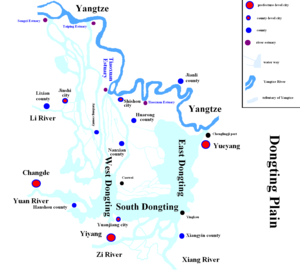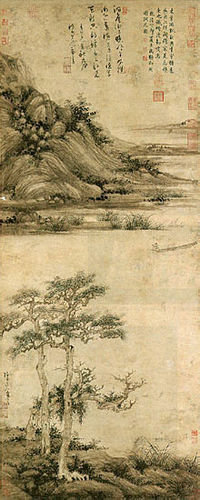Dongting Lake
| Dongting Lake | |
|---|---|
| Tung-tʻing Lake | |
 | |
| Location | Hunan Province |
| Coordinates | 29°18′36″N112°57′00″E/ 29.31000°N 112.95000°E |
| Primary inflows | Yangtze,Xiang,Zi,Yuan,Li |
| Primary outflows | Yangtze |
| Basincountries | China |
| Surface area | 2,820 km2(1,090 sq mi) flood season: 20,000 km2(7,700 sq mi) |
| Official name | Dong-ting hu |
| Designated | 31 March 1992 |
| Reference no. | 551[1] |
| Dongting Lake | |||||||||||||||||||||||
|---|---|---|---|---|---|---|---|---|---|---|---|---|---|---|---|---|---|---|---|---|---|---|---|
"Lake Dongting" in Chinese characters | |||||||||||||||||||||||
| Chinese | Động đình hồ | ||||||||||||||||||||||
| Literal meaning | "Grotto Court Lake" | ||||||||||||||||||||||
| |||||||||||||||||||||||

Dongting Lake(Chinese:Động đình hồ) is a large, shallowlakein northeasternHunan Province,China.It is a flood basin of theYangtze River,so its volume depends on the season. The provinces ofHubeiand Hunan are named after their location relative to the lake:Hubeimeans "North of the Lake" andHunan,"South of the Lake".[2]
Dongting Lake is famous in Chinese culture as the place of origin ofdragon boat racing.It is the site ofJunshan Islandand is home to the critically endangeredYangtze finless porpoise.[2]
Geography[edit]


In the July–September period, flood water from theYangtzeflows into the lake, enlarging it greatly. The lake's area, which normally is 2,820 km2or 1,090 sq mi (data before 1998), may increase to 20,000 km2(7,700 sq mi) in flood season, when vast amounts of water and sediment from the Chang Jiang flow into the lake. The lake is also fed by four major rivers: theXiang,Zi,YuanandLirivers. Small rivers also flow in, the most famous being theMiluo River,where the loyal official and poetQu Yuancommitted suicide in the early 3rd century BC, according to tradition. In addition, theXiao Riverflows into the Xiang nearYongzhou,before the Xiang flows into the lake. Ocean-going vessels can travel through the Xiang to reachChangsha.[3]
River and Lake[edit]
The Dongting Lake catchment area is 257,000 km2(99,000 sq mi). The lake's only outlet is a natural channel 14 km long and on average 1 km wide. There are four main rivers in the catchment (excluding the area whose water flows directly into the Yangtze River, the same hereafter): theXiang,Zi,Yuan,andLishuirivers, which flow directly into the lake. In addition, some of water of the Yangtze River also flows into the lake through the Sankou distributary channels. The catchment has highly complex flow regimes featuring strong river-lake interactions. Dongting Lake receives water from the upper Jingjiang reach of the Yangtze River. The water in Dongting Lake finally flows into the lower Jingjiang reach of the Yangtze River at theChenglingjiStation and discharges downstream. The water in Dongting Lake mainly comes fromsurface runoffand direct rainfall on the lake surface. The Dongting Lake catchment begins to enter the rainy season in April and the rainfall reaches its maximum in June. Then, the rainy area moves to the upper part of the Yangtze River Basin in July and flood water flowing into the lake from upstream increases significantly. The rainy season may continue until the end of September. The flow regime of Dongting Lake maintains the same temporal pattern as the rainfall regime. The flood season is from April to September. In general, flood water comes mainly from the catchment from April to June and from water diversion of the upper reaches of the Yangtze River from July to September. The annual runoff from Dongting Lake to the Yangtze River is 278.6 km3/a (8,830 m3/s), of which to 92.3 km3/a (2,920 m3/s) is received from the Yangtze River through the inlets. Influenced by the monsoon, the lake shows a significant seasonal change in its flow regime. The lake water level fluctuates dramatically throughout a year, up to 12.9 m (42 ft). The water surface area also varies with the fluctuation of the water level from thousands of square kilometers in the flood season to only a few hundred square kilometers in the dry season.[4][5]
History[edit]
The earliest rice paddies yet discovered in the world were in the Liyang plain, which was then on the western edge of Dongting lake.[6]The state of Chu occupied the region in theEastern Zhou period,and its territory there was taken over byQinin the 3rd century BCE. During theHan dynasty,Yunmeng Marsh (Vân mộng đại trạch;Yúnmèng dàzéliterally "Great Marsh of Cloud Dream" ), which lies to the north of Dongting Lake in Hubei Province, served as the main flood-basin of the Yangtze. The rich sediment of the marsh attracted farmers. Embankments were built, keeping the river out, and the Dongting Lake area south of the Yangtze gradually became the river's main flood-basin. The Han state was actively involved in the colonization of the region, maintaining dikes in Liyang to protect farmland from flooding.[7]
At that time, Dongting Lake was China's largest freshwater lake. Because of its size, it gained the nameEight-hundred-li-Dongting(Bát bách lí động đình). Nowadays, it is the second-largest, afterPoyang Lake,as much of the lake has beenturned into farmland.[8][9]
Culture and mythology[edit]

The area is well known inChinese historyandliterature."Dongting" literally means "Grotto Court", and the lake was named for the huge hall or cavern, which was believed to exist beneath the lake, where the spirits of the Sage-KingShun's wivesEhuang and Nüyingwere said to be the rulers of this grotto, which was claimed to have underground passages opening to all parts of the empire.[10][11]Dragon boat racing is said to have begun on the eastern shores of Dongting Lake as a search for the body ofQu Yuan,the Chu poet (340–278 BC), and adragon-kingis said to live at the bottom of the lake.
Junshanwas also named after the goddess-wives of Shun, who lived there after his death by drowning, while they mourned him and sought for his body all the way from the source of the Xiang River, in which he drowned, and then on down to where it could have drifted, into the lake.[12]Junshan Island, a formerTaoistretreat, is a famous 1 km (0.62 mi)-wide island with 72 peaks in the middle of the lake. The island is also famous for itsJunshan Yinzhen tea.[13]The basin of Dongting Lake and its surrounding area is famous for its scenic beauty, which has been encapsulated in the phrase "Hunan of theXiao and Xiangrivers "(Tiêu tương hồ nam;Xiāo-Xiāng Húnán).[citation needed]
The scenery of theJiuyi Mountainsand of the Xiao and Xiang rivers below is often mentioned inChinese poetry.Thelate Tang dynasty poetYu Wulingis supposed to have been fond of the scenery of Dongting Lake.[14]During theSong dynasty,it became the fashion to paint this region's scenery in a set of eight scenes, usually entitled asEight Views of Xiaoxiang.It is also said thatHan Shizhongsettled in the region after retired from military service. The fashion spread toJapan,where eventually other famous places were substituted for the Xiao and Xiang rivers.[citation needed]One of the famous ponds based on the geography of the lake is at theDaikaku-jiin Kyoto.
Environmental issues[edit]
This sectionneeds additional citations forverification.(December 2020) |
The agricultural colonization of the region began in ancient times, and by the 19th century much of the lake's shallower areas had been destroyed to create farmland.[15]After 1949 a new round of wetland drainage destroyed much of what remained, leaving only a fraction of the original wetland intact, though some of that area has subsequently been returned to wetland conditions. Nonetheless, along with Poyang Lake, it remains one of the largest lakes in China, and is an important wintering area for migratory birds. It has been designated as a protectedRamsar sitesince 1992.[1]
In 2007 fears were expressed that China'sfinless porpoise,a native of the lake, might follow thebaiji,theYangtzeriver dolphin, into extinction. There have been calls for action to save the finless porpoise, of which there are about 1400 left living, with approximately 700 to 900 in the Yangtze, and approximately another 500 inPoyangand Dongting Lakes. The 2007 population levels were less than half the 1997 levels, and the population continues to drop at a rate of 7.3 per cent per year. Pressure on the finless porpoise population on Poyang Lake comes from the high numbers of ships passing through, as well assand dredging.[16]
After flooding of the Yangtze River in late June 2007, approximately 2 billion mice were displaced from the islands of the lake when water was released from theThree Gorges Damto control the excess. The mice invaded surrounding communities, damaging crops and dikes and forcing the government to construct walls and ditches to control the population.[17]Villagers killed an estimated 2 million mice by beating them to death or using poisons, which also had an adverse effect on their predators.[18]
The lake was also featured on news services as having a problem withschistosomaandmalariainfected mosquitoes.[citation needed]
A restoration project, the Sino-Norwegian Project of Biodiversity Protection Management, began in 2005. According to a 2007 article in theChina Daily,"[The Dongting Lake area] will be restored to a sustainable biodiversity environment within five to 10 years".[19]
Major cities on the lake[edit]
See also[edit]
- Eight Views of Xiaoxiang
- Emperor Shun
- Hunan
- Junshan Island
- Spotted bamboo
- Xiang River
- Xiang River goddesses
- Xiaoxiang
- Xiaoxiang poetry
- Yangzi River
References[edit]
Citations[edit]
- ^ab"Dong dongting hu".RamsarSites Information Service.Retrieved25 May2020.
- ^abWei Ming (2013),p. 39.
- ^Wei Ming (2013),p. 39–40.
- ^Xi-jun, Lai; Zi-min, Wang (2017).Flood management of Dongting Lake after operation of Three Gorges Dam.
- ^"Yuan Jiang".
- ^Zhang Chi trương thỉ, “The Qujialing-Shijiahe Culture in the Middle Yangzi River Valley,” in A Companion to Chinese Archaeology, ed. Anne P. Underhill (Chichester: John Wiley & Sons, 2013), 510–34.
- ^Brian Lander, “State Management of River Dikes in Early China: New Sources on the Environmental History of the Central Yangzi Region.” T’oung Pao 100.4-5 (2014): 325–362.
- ^Wei Ming (2013),p. 40.
- ^Peter Perdue, Exhausting the Earth: State and Peasant in Hunan 1500–1850 (Cambridge: Harvard Univ. Council on East Asian Studies, 1987).
- ^Wei Ming (2013),p. 41.
- ^Murck, Alfreda (2000).Poetry and Painting in Song China: The Subtle Art of Dissent.Harvard Univ Asia Center. pp. 8–10.ISBN978-0-674-00782-6.
- ^Murck (2000),pp. 9–10.
- ^Wei Ming (2013),p. 41–42.
- ^Ueki et al. 1999,pp. 133–4.
- ^Brian Lander, “State Management of River Dikes in Early China: New Sources on the Environmental History of the Central Yangzi Region.” T’oung Pao 100 (2014): 287-324; Peter Perdue, Exhausting the Earth: State and Peasant in Hunan 1500–1850 (Cambridge: Harvard University Council on East Asian Studies, 1987).
- ^"Poyang Lake: Saving the finless porpoise".9 March 2007.Archivedfrom the original on 2016-03-04.Retrieved2016-02-08.www.chinadialogue.net - Poyang Lake saving the finless porpoise
- ^"2 Billion Chinese Mice Overrun Lake Area".Archived fromthe originalon 2007-07-11.Retrieved2007-07-10.www.physorg.com - 2 Billion Chinese Mice Overrun Lake Area
- ^Watts, Jonathan (2007-07-17)."'Rats' on the menu after China swamped by 2 billion rodents ".The Guardian.Retrieved2020-12-18.
- ^"Lake back to health in 5 to 10 years"[permanent dead link](on the website of theMinistry of Water Resources of the People's Republic of China.)
Sources[edit]
- Wei Ming (2013). "Dongting Lake".Famous Lakes in China(in English and Chinese). Huangshan City, Anhui: Huangshan Publishing House.ISBN978-7-5461-2500-8.
- Ueki, Hisayuki;Uno, Naoto;Matsubara, Akira(1999).Matsuura, Tomohisa(ed.).Kanshi no JitenHán thi の sự điển(in Japanese). Vol. 1. Tokyo: Taishūkan Shoten.OCLC41025662.

